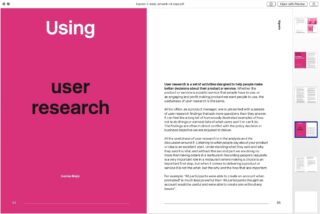
User research is a set of activities designed to help people make better decisions about their product or service. Whether the product or service is a public service that people have to use, or an engaging and profit making product we want people to use, the usefulness of user research is the same.
All too often, as a product manager, one is presented with a parade of user research findings that ask more questions than they answer. It can feel like a long list of humorously illustrated examples of how not to do things or earnest lists of what users won’t or can’t do. The findings are often in direct conflict with the policy decision or business objective we are required to deliver.
All the usefulness of user research is in the analysis and the discussion around it. Listening to what people say about your product or idea is an excellent start. Understanding what they said and why they said it is vital, and without this second part we are doing no more than taking orders in a restaurant. Recording people’s requests is a very important role in a restaurant where making a choice is an important first step, but when it comes to delivering a product or service it is not the what, but the why and the how that are important.
For example: “All participants were able to create an account when prompted” is much less powerful than “All participants thought an account would be useful and were able to create one without any issues”.
In our restaurant scenario we might record that everyone who walked in ordered ice cold water. As good restaurant staff we would serve them their water. As user researchers we would be far more interested in the fact that everyone who walked in was feeling hot. What was causing them to feel hot? How does that affect their behaviour in our restaurant? We might conclude that because they feel hot people are ordering less, drinking too much water and not enough food and wine.
As designers we must then investigate how we could solve this: give people a fan as they walk in, turn the heating down, open more windows, install cold showers? Each of these would solve the problem.
As product owners we must understand and choose the right solution for our restaurant. Fans are more expensive, installing showers is probably not appropriate for a restaurant experience. Depending on the time of year addressing the heating and the airflow would be the kind of solution to look at. We could also just give everyone a glass of ice cold water before they ask.
As product managers, we can be tasked with delivering an online version of something that people do quite happily using offline channels and seem to have no desire to change that. Or creating an online tool to pay a bill nobody wants, like a parking ticket for example. Understanding whether our product is going to be used in times of stress or crisis, or in moments of great joy. At a party with a drink in one hand, or racing through an airport, or sitting on a train with time to kill will make a huge difference to what matters.
User research will report on the stress, frustration, the lack of engagement or the joy and delight. It will help us understand why it matters and how much it matters.
If people are under pressure our interfaces can be more helpful, more understanding, more forgiving of error.
If the task is particularly mundane we can make it as efficient as possible.
If it is a product that is designed to delight, then we can delight in our design.
If our product is going to present a challenge to our users because of a policy or strategic decision, then as product managers we need to know. Once we understand the impact we can make the right decision for the product we are delivering.
User research will invariably uncover lots of really interesting things: good stories that make for a fascinating presentation, amusing quotes, lists of what people said they want. The range of possible solutions comes from engaging in meaningful conversation with design, technology, communication, policy. The product owner is the person who has to balance what is possible technically, works for the user, and delivers on policy intent and choose the right solution. Understanding the why is critical to that.
We need to understand why people are thirsty before we can decide what to do about it. If anything.